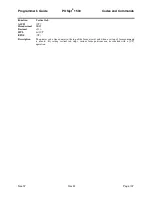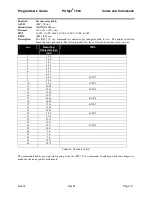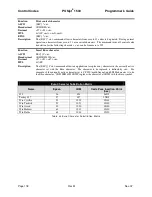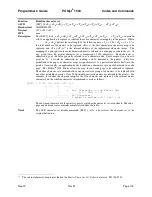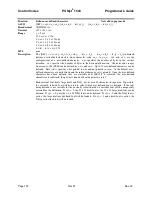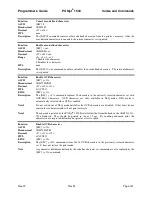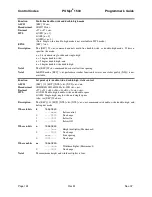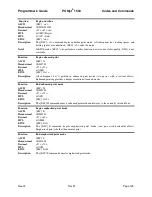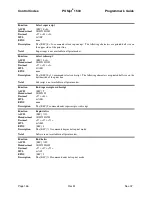
Programmer's Guide
POSjet
®
1500
Codes and Commands
Nov-07
Rev M
Page 115
Character sets and Code Pages
The POSjet
®
1500 Printer supports 65 different international character sets. In IBM and EPOS printers, there are two
ways of selecting a character set. One way substitutes international characters in the upper 128 characters of a
standard character set. The substitution technique supports a few different countries. However, as more and more
countries were added, too many characters were being replaced. It became a problem for the application to match
the characters displayed and printed. To solve the problem, a second method of selecting a character set was
developed - code pages. The printer and display use the same code page. The application displays and prints the
same characters. IBM and EPOS defined new commands to select code pages and left the old commands in effect.
The POSjet
®
1500 Printer supports international character sets as well as code pages. To allow the most flexibility
for the application programmer, both methods are extended in the POSjet
®
1500 Printer. In IBM mode, there are 19
character sets and 60 code pages. In EPOS mode, there are 57 character sets and five code pages.
11
The POSjet
®
1500 Printer allows the IBM code page selection command to choose character sets as well as normal
IBM code pages. The EPOS character set select command has been extended to allow additional character sets over
and above the 11 defined by EPOS. The EPOS code page select command has not been extended because there is
no EPOS definition beyond the first six ID’s.
All characters in code pages as well as character sets are addressed as zero through 255. (Characters below 32 must
be addressed with the [ESC] ^ <n> command.) Code pages may be changed at any time and are active for all
features including rotated print. To allow other code pages to be created by an application, a redefine character set
command is provided.
As discussed above, there are two commands for language selection in IBM mode. The first is [ESC] !, which
selects one of 19 international character sets. The [ESC]! command does not allow all of the possible character sets
to be selected, it is provided for compatibility with older programs only. The second is [ESC][ T, which selects any
of the 58 code pages. In EPOS mode, the [ESC] R command has been expanded to select any of the 59 international
character sets or code pages.
Function
Select international character set
ASCII
[ESC] ! <n>
Hexadecimal
1BH 21H <n>
Decimal
<27> <33> <n>
IPCL
&%CS <n>
EPOS
[ESC] R <n>
Description
The [ESC] ! <n> command selects international character set <n>. In standard mode, the value of
<n> is as follows.
<n>
Language
<n>
Language
64-‘@’
ASCII (slashed zero)
73-‘I’
Italian
65-‘A’
ASCII (unslashed zero)
74-‘J’
French Canadian
66-‘B’
British
75-‘K’
Spanish
67-‘C’
German
76-‘L’
Swedish II
68-‘D’
French
77 -‘M’
Swedish III
69-‘E’
Swedish
78-‘N’
Swedish IV
70-‘F’
Danish
79-‘O’
Turkish
71-‘G’
Norwegian
80-‘P’
Swiss I
72-‘H’
Dutch
81-‘Q’
Swiss II
Table 32 Language Table ID’s
Function
Select character code page
12
11
Epson provides limited code page support through ID to code page translation. Only six translations are
defined.
12
There is an Arabic Character set available on special order with some emulation restrictions.
Summary of Contents for POSJET 1500
Page 1: ...PROGRAMMER S GUIDE POSjet 1500 PN 20 03398 Rev M Nov 2007...
Page 14: ......







